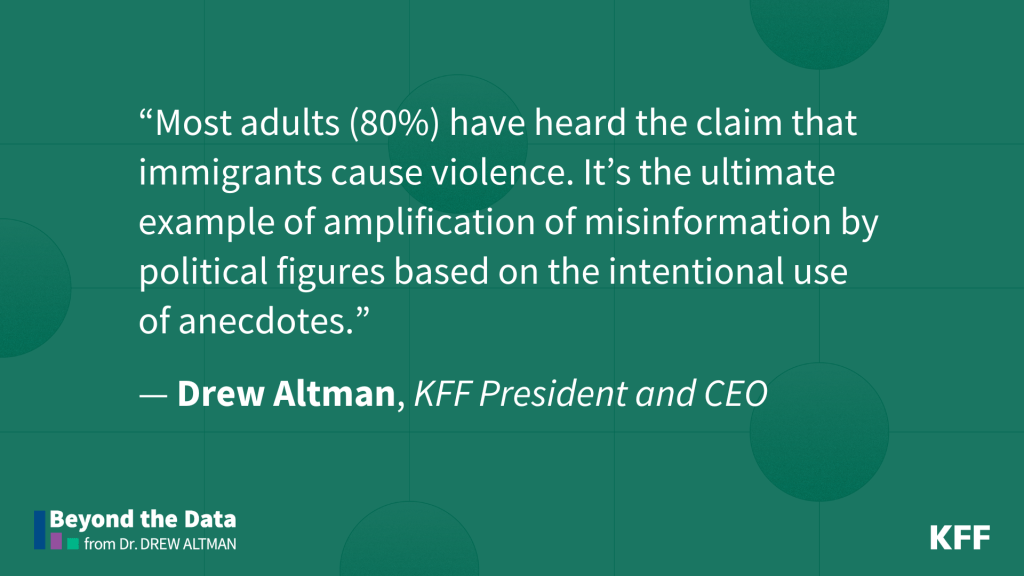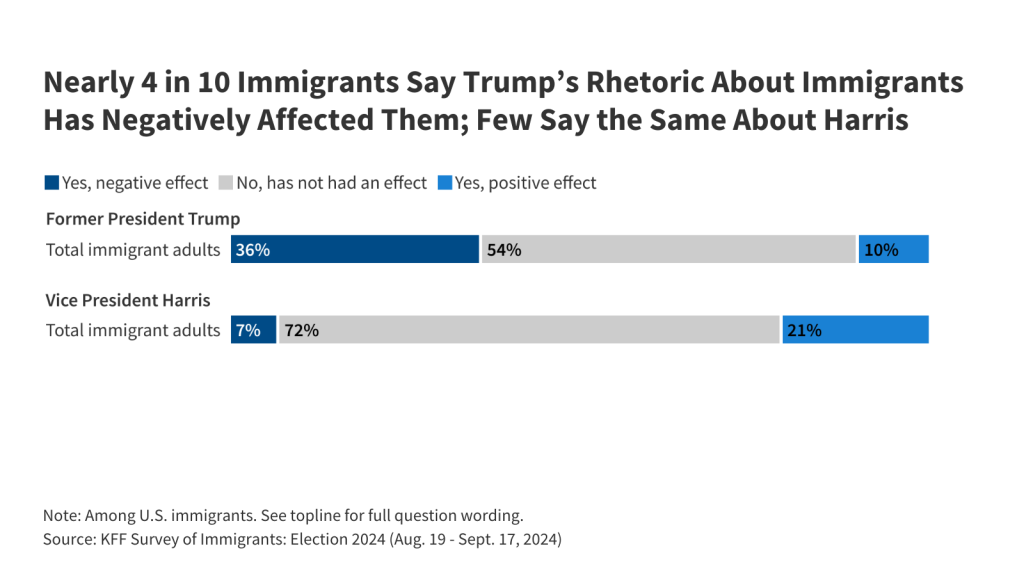VOLUME 7
Political Rhetoric Spreads Misinformation About Fentanyl
This is Irving Washington and Hagere Yilma. We direct KFF’s Health Misinformation and Trust Initiative and on behalf of all of our colleagues across KFF who work on misinformation and trust we are pleased to bring you this edition of our bi-weekly Monitor.
Summary
In this edition, we look at how political rhetoric is driving misinformation about fentanyl and immigration. We also highlight the legal implications of fentanyl-laced counterfeit pills sold on social media, address myths about opioid exposure, and discuss how AI may help counter these narratives.
Featured

In his latest Beyond the Data column, KFF CEO Drew Altman examines how media coverage can inadvertently amplify politicians’ misinformation about immigrants. He cites a recent incident in Springfield, Ohio, where false claims about Haitian immigrants, initially made by political candidates, gained traction through media coverage. Altman observes that some politicians are exploiting feelings of alienation among certain Americans by scapegoating immigrants. This misinformation can have serious consequences, especially for Black immigrants who face both racism and anti-immigrant sentiment. He emphasizes that the media must be careful when reporting on such political falsehoods, as repeated coverage showing clips of false statements, even if followed by fact checking, can unintentionally reinforce misinformation.
Recent Developments
Latest KFF Poll Explores Exposure, Belief, and Impact of Misinformation About Immigrants
The latest KFF Health Misinformation Tracking Poll (conducted before the September 10 presidential debate) highlights how misinformation about immigrants is being shared by politicians leading up to the election, with many adults exposed to both false and true claims but remaining unsure of their truthfulness. The September Health Misinformation Tracking Poll found that large majorities of adults have heard elected officials or candidates make the false claims that immigrants are causing an increase in violent crime (80%) or taking jobs and increasing unemployment for U.S.-born adults (74%; Figure 1). While a majority have heard the true statement that immigrants help to fill labor shortages in some industries (69%), far fewer have heard candidates or elected officials make the true claim that immigrants pay billions in taxes annually (31%).
Despite this exposure, most people say these statements are either “probably true” or “probably false,” reflecting widespread uncertainty (Figure 2). However, Republicans are far more likely than Democrats or independents to say false claims about immigrants are “definitely true.” Additionally, about half of U.S. adults, including a similar share of immigrants, either incorrectly believe undocumented immigrants are eligible for federally funded health insurance programs or say they are unsure. This misinformation has implications for immigrant health and well-being. The poll also found that nearly four in ten immigrants (36%), including nearly half of Asian immigrants (45%), say former President Trump’s rhetoric has negatively impacted the way they are treated in the U.S. On the other hand, most immigrants (72%) say Vice President Harris’s statements have not affected their treatment, while about one in five say her rhetoric has had a positive effect.
Politicians Incorrectly Link Fentanyl to Migration to Garner Support for Immigration Policy
During this election season, politicians are sharing misinformation about fentanyl and migration to instill fear and promote stricter border policies. Former President Donald Trump and Vice Presidential Candidate JD Vance have repeatedly claimed that undocumented immigrants are responsible for the influx of fentanyl into the U.S., criticizing President Biden and Vice President Harris’ immigration policy and suggesting that building border walls could reduce drug flow. These claims are misleading and not new. An NPR-Ipsos poll from 2022 found that nearly 4 in 10 Americans believe that “most of the fentanyl entering the U.S. is smuggled in by unauthorized migrants crossing the border illegally”. In reality, federal data analyzed by KFF indicates that most fentanyl enters the U.S. through legal ports of entry and is trafficked primarily by U.S. citizens, not migrants.
As fentanyl continues to drive overdose deaths in the U.S., these misleading claims are resonating with some grieving parents who have lost children to fentanyl overdoses and are looking for decisive action against the opioid crisis. A new KFF analysis shows that fentanyl has driven a 23-fold increase in opioid deaths over the past decade, making it the primary cause of overdose fatalities, despite a decline in overall opioid deaths in late 2023. But experts argue that stricter immigration policies will not effectively combat the opioid epidemic. This type of rhetoric misplaces blame, contributing to stigmatization and harmful policies that adversely affect immigrant health. Focusing on this false link neglects the real factors driving fentanyl and opioid overdoses in the U.S., such as misconceptions about treatments for opioids.
Fentanyl-Laced Fake Drugs on Social Media Raises Questions About Accountability
Social media platforms have increasingly contributed to the rise of fentanyl use among youth. Platforms like Instagram, Snapchat, and Telegram have become key venues for drug distribution, allowing young users to order illicit substances, often without knowing they’re laced with fentanyl. Even though social media companies are trying to crack down on drug sales, experts say it’s not enough to keep users safe. Some grieving parents, who’ve lost children to fentanyl-laced pills, are suing companies like Snap for negligence in these tragic fatalities. This legal battle has broader implications for Section 230, which currently provides immunity to online platforms for content posted by users. If these cases succeed, it could lead to stricter rules and more accountability for social media companies.
One way to determine if prescription drugs contain fentanyl is by using fentanyl test strips. Although there is uncertainty about how consistently fentanyl test strips detect fentanyl across brands, lots, and drug combinations, they can still serve as effective harm reduction measures by identifying fentanyl and its analogs in drug samples at low concentrations. Unfortunately, a widespread myth persists that fentanyl contamination is impossible to detect, which keeps many from using these strips. Critics also argue that making fentanyl test strips available might encourage drug use, causing some states to classify them as drug paraphernalia. But harm-reduction evidence shows they prevent overdoses without increasing consumption and a KFF Issue Brief explains that some states are changing their policies to allow access to fentanyl test strips because of the rise of illicit fentanyl in drug supplies. By spreading the myth that fentanyl contamination is undetectable or leads to more drug use, individuals overlook practical solutions that could mitigate the risk and protect vulnerable populations.
Emerging Misinformation Narratives
Myths About Fentanyl Exposure
A common myth surrounding fentanyl is that simply touching it can be fatal. This fear has been spread by some media reports and misinformed statements. Fentanyl is a powerful opioid, but it isn’t absorbed through the skin or through casual contact.
There have been several high-profile cases where police officers or first responders claimed to have collapsed or overdosed just by touching fentanyl, but medical experts have consistently debunked these reports. In July 2023, multiple local news outlets reported on incidents involving police officers who claimed to have been exposed to fentanyl during their duties. One officer in Indiana stated they had passed out after accidentally inhaling the drug, while another in Colorado reported collapsing after touching it. Similar claims have surfaced in recent years, often sparking discussions on social media. While some users express concern, others question the validity of these reports. For example, in response to the recent incidents, a doctor shared a popular post on X stating, that fentanyl cannot be accidentally inhaled, as it must be snorted or vaporized.
The misconception that simply touching or inhaling fentanyl can lead to overdose can be traced back to an advisory statement issued by the DEA in 2016. Even though experts have repeatedly debunked these myths, public fear of fentanyl remains high. Widespread concerns about the drug are understandable, as fentanyl is involved in more than 70 percent of U.S. overdose deaths, but false narratives about the drug may be drowning out factual information intended to prevent fentanyl-related deaths.
Research Updates
The Role of Media in Combatting Health-Related Misinformation in Political Rhetoric
A study in Journalism Studies that examined media coverage of misinformation during the 2016 and 2020 U.S. presidential elections offers insight into how media outlets addressed election-related false claims. The study identified three core strategies for correcting election-related misinformation: emphasizing correct information without repeating the false claims, adopting a more assertive tone to debunk inaccuracies, and using credible sources to appeal to diverse audiences, including skeptics. As health misinformation continues to underlie political rhetoric leading up to the election, these media approaches could help shape public understanding and counteract harmful narratives.
Source: Juarez Miro, C., & Anderson, J. (2024). Correcting False Information: Journalistic Coverage During the 2016 and 2020 US Elections. Journalism Studies, 25(2), 218-236.
Debunking Misinformation May Be More Effective Than Prebunking
A study published in Nature found that debunking misinformation is slightly more effective than prebunking when it comes to correcting false claims. Researchers tested both strategies on over 5,000 participants across multiple European countries, examining how these interventions impacted belief in misinformation. While both methods worked, debunking — delivered after people were exposed to false claims — had a small advantage. However, the study also highlighted the role of trust: debunking was less effective when participants had low trust in the source delivering the correction, emphasizing that trust in institutions remains a factor in countering misinformation effectively.
Source: Bruns, H., Dessart, F. J., Krawczyk, M., Lewandowsky, S., Pantazi, M., Pennycook, G., … & Smillie, L. (2024). Investigating the role of source and source trust in prebunks and debunks of misinformation in online experiments across four EU countries. Scientific Reports, 14(1), 20723.
AI and Emerging Technologies
Personalized AI Debunking: A New Approach to Countering Conspiracy Theories
Personalizing debunking efforts can effectively counter conspiracy theories by tailoring arguments to address the specific evidence individuals believe supports their views. A recent study published in Science found that when participants engaged in a personalized, in-depth dialogue with an AI tool designed to refute conspiracy theories, their belief in those conspiracies decreased significantly, with effects lasting for months. This approach challenges the notion that conspiracy beliefs are impervious to change and suggests that AI tools, which can sustain individualized, evidence-based conversations, may be powerful resources for mitigating harmful beliefs.
Support for the Health Information and Trust initiative is provided by the Robert Wood Johnson Foundation (RWJF). The views expressed do not necessarily reflect the views of RWJF and KFF maintains full editorial control over all of its policy analysis, polling, and journalism activities. The Public Good Projects (PGP) provides media monitoring data KFF uses in producing the Monitor.


 Irving Washington
Irving Washington  Hagere Yilma
Hagere Yilma 

























